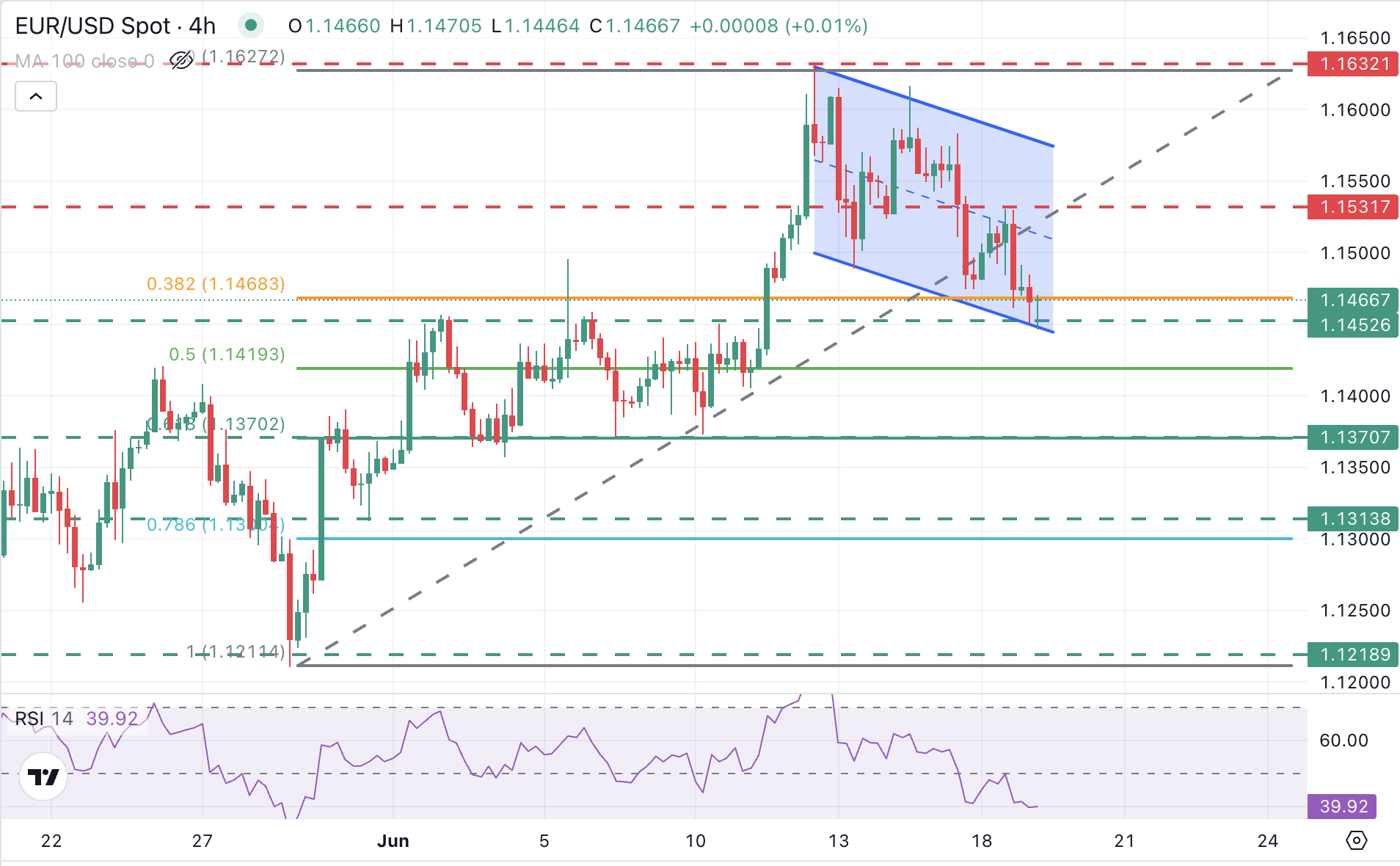Created
: 2025.06.19














![]() 2025.06.19 17:16
2025.06.19 17:16
The EUR/USD pair is extending its reversal from last week's highs on Thursday, weighed by investors' aversion to risk, as fears of an escalation of the Israel-Iran war into a regional conflict have overshadowed the Federal Reserve's (Fed) monetary policy decision. The common currency broke below the 1.1500 level and is trading around 1.1450 at the time of writing.
US President Donald Trump stole the central bank's spotlight on Wednesday, leaving the world guessing whether the US may join Israel in its attack on Iran, and a report from Bloomberg, released somewhat later, suggested that US officials might be preparing to enter the war, probably on the weekend.
The US Dollar (USD) is drawing support from investors' risk-off reaction amid growing concerns that the conflict might escalate into a regional war, threatening the Oil supply and adding a new layer of uncertainty in the already strained global growth prospects.
The Federal Reserve left its benchmark interest rate unchanged at the 4.25%-4.50% range after its monetary policy meeting on Wednesday, and maintained the previous projections of 50 basis points (bps) cuts in the second half of the year.
Chairman Jerome Powell, however, curbed investors' enthusiasm, warning that inflation will increase in the coming months as the impact of tariffs starts to filter in. The US Dollar, which had eased after the decision, regained lost ground following Powell's hawkish rhetoric.
The table below shows the percentage change of Euro (EUR) against listed major currencies today. Euro was the strongest against the New Zealand Dollar.
| USD | EUR | GBP | JPY | CAD | AUD | NZD | CHF | |
|---|---|---|---|---|---|---|---|---|
| USD | 0.21% | 0.25% | 0.04% | 0.26% | 0.71% | 0.94% | 0.19% | |
| EUR | -0.21% | 0.05% | -0.18% | -0.01% | 0.44% | 0.69% | -0.06% | |
| GBP | -0.25% | -0.05% | -0.23% | -0.05% | 0.40% | 0.73% | 0.09% | |
| JPY | -0.04% | 0.18% | 0.23% | 0.18% | 0.53% | 0.81% | 0.22% | |
| CAD | -0.26% | 0.00% | 0.05% | -0.18% | 0.37% | 0.70% | 0.12% | |
| AUD | -0.71% | -0.44% | -0.40% | -0.53% | -0.37% | 0.38% | -0.38% | |
| NZD | -0.94% | -0.69% | -0.73% | -0.81% | -0.70% | -0.38% | -0.68% | |
| CHF | -0.19% | 0.06% | -0.09% | -0.22% | -0.12% | 0.38% | 0.68% |
The heat map shows percentage changes of major currencies against each other. The base currency is picked from the left column, while the quote currency is picked from the top row. For example, if you pick the Euro from the left column and move along the horizontal line to the US Dollar, the percentage change displayed in the box will represent EUR (base)/USD (quote).

EUR/USD broke below a small triangle pattern on Tuesday, and confirmed its immediate bearish trend on Wednesday, breaching the 1.1500 support Area. The pair is in a corrective phase, after the early-June rally, with technical indicators in the 4-hour charts well within bearish territory, suggesting that further decline is likely.
Price action is now testing support at the 1.1450-1.1470 area, where the pair's upside was halted on June 2, 8, and 10, and the base of the descending channel from June 12 highs meets the 38.2% Fibonacci retracement of the previously mentioned rally. Below here, the next support is at 1.1370, the June 6 and 10 lows, and the 61.8% Fibonacci retracement level.
On the upside, immediate resistance is at Tuesday's high of 1.1530 ahead of last week's highs at 1.1630, the highest since November 2021.
Monetary policy in the US is shaped by the Federal Reserve (Fed). The Fed has two mandates: to achieve price stability and foster full employment. Its primary tool to achieve these goals is by adjusting interest rates. When prices are rising too quickly and inflation is above the Fed's 2% target, it raises interest rates, increasing borrowing costs throughout the economy. This results in a stronger US Dollar (USD) as it makes the US a more attractive place for international investors to park their money. When inflation falls below 2% or the Unemployment Rate is too high, the Fed may lower interest rates to encourage borrowing, which weighs on the Greenback.
The Federal Reserve (Fed) holds eight policy meetings a year, where the Federal Open Market Committee (FOMC) assesses economic conditions and makes monetary policy decisions. The FOMC is attended by twelve Fed officials - the seven members of the Board of Governors, the president of the Federal Reserve Bank of New York, and four of the remaining eleven regional Reserve Bank presidents, who serve one-year terms on a rotating basis.
In extreme situations, the Federal Reserve may resort to a policy named Quantitative Easing (QE). QE is the process by which the Fed substantially increases the flow of credit in a stuck financial system. It is a non-standard policy measure used during crises or when inflation is extremely low. It was the Fed's weapon of choice during the Great Financial Crisis in 2008. It involves the Fed printing more Dollars and using them to buy high grade bonds from financial institutions. QE usually weakens the US Dollar.
Quantitative tightening (QT) is the reverse process of QE, whereby the Federal Reserve stops buying bonds from financial institutions and does not reinvest the principal from the bonds it holds maturing, to purchase new bonds. It is usually positive for the value of the US Dollar.
![]()
Created
: 2025.06.19
![]()
Last updated
: 2025.06.19

FXStreet is a forex information website, delivering market analysis and news articles 24/7.
It features a number of articles contributed by well-known analysts, in addition to the ones by its editorial team.
Founded in 2000 by Francesc Riverola, a Spanish economist, it has grown to become a world-renowned information website.
We hope you find this article useful. Any comments or suggestions will be greatly appreciated.
We are also looking for writers with extensive experience in forex and crypto to join us.
please contact us at [email protected].
Disclaimer:
All information and content provided on this website is provided for informational purposes only and is not intended to solicit any investment. Although all efforts are made in order to ensure that the information is correct, no guarantee is provided for the accuracy of any content on this website. Any decision made shall be the responsibility of the investor and Myforex does not take any responsibility whatsoever regarding the use of any information provided herein.
The content provided on this website belongs to Myforex and, where stated, the relevant licensors. All rights are reserved by Myforex and the relevant licensors, and no content of this website, whether in full or in part, shall be copied or displayed elsewhere without the explicit written permission of the relevant copyright holder. If you wish to use any part of the content provided on this website, please ensure that you contact Myforex.
Myforex uses cookies to improve the convenience and functionality of this website. This website may include cookies not only by us but also by third parties (advertisers, log analysts, etc.) for the purpose of tracking the activities of users. Cookie policy